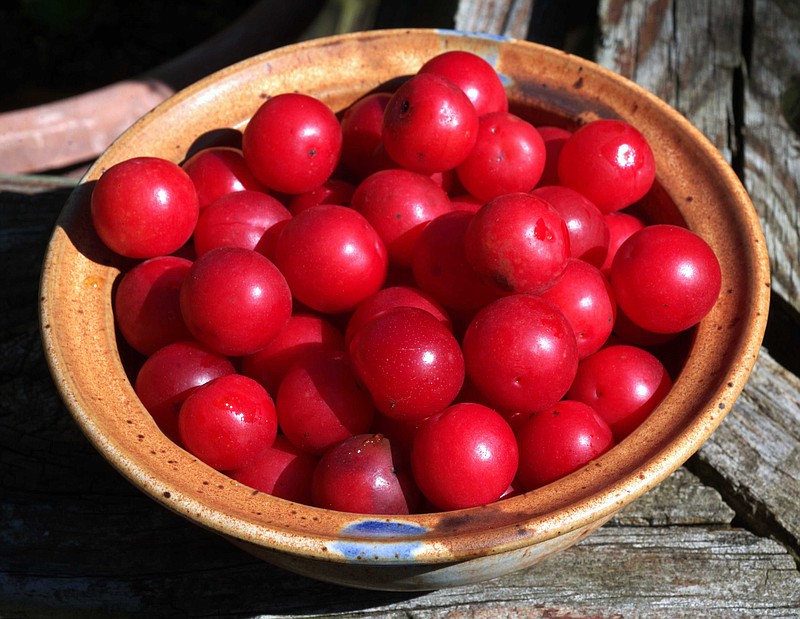Wild plum, or Prunus americana, may be the wallflower of native fruit trees - because even though it is one of the most abundant native trees, it usually goes unnoticed as it grows along roadsides on major highways and smaller roads.
Wild plum can be found in the most unexpected places, sometimes forming thickets, and has fruits that are smaller than commercial plums, about the size of regular crabapples, with a flavor far more desirable than introduced plums.
Like many fruit trees, wild plum blooms early in the spring and matures its fruit in late summer. It blooms at the same time as the invasive Bradford pear, so some ways to tell them apart are that Bradford pear trees are taller, their flowers have a stronger and unpleasant smell, and Bradford fruits are green, small and inedible.
American plums should be harvested when they are red, and they can be left out on the kitchen counter for two or three days before using. They should be soft but not mushy, and can be used raw or cooked. Tartness varies from tree to tree.
Wild plum's aromatic flowers can be used to produce perfumes. The fruits of wild plums are red at maturity and round or oval-shaped. Wild plums can be found naturally in thickets in prairies, glades and open woodlands, but can be trained to have a single stem, which makes it easier to harvest the bright-red fruits. A fast-growing tree, it can produce fruits within four or five years after seeding and can reach up to 20 feet, but has an average size of about 10 feet.
Wild plum, like introduced plums, pears and apples, belong to the rose family. The Missouri Department of Conservation recommends wild plums for quail habitat in combination with brambles and other small trees and shrubs. Native plums are adapted to dry and poor soils and do not require watering once established. The fruits are consumed by bobwhite quail, turkey and mammals.
Wild plums have been used extensively and are still used by Native Americans, according to Kelly Kindscher, professor of the Environmental Studies Program at the University of Kansas. A study conducted by Katherine Phillips et. al. on wild plum and nine other native edible species used by Northern Plains Native Americans showed that wild plums had high dietary fiber content, Vitamin C and Vitamin K.
Because of its wide distribution across the country, numerous books and websites provide recipes using wild plum. Wild plums can be used in any jam or jelly recipe calling for plums and have an unbeatable flavor!
Wild plums as well as other native edible plants can be seen at the Lincoln University campus as part of the FINCA project. (A finca is a small farm in El Salvador, and at Lincoln it is the acronym of "Families Integrating Nature, Conservation and Agriculture.") This project, funded by the National Institute of Food and Agriculture, is helping to increase awareness about common but overlooked native edibles in Missouri.
Please visit us at the Lincoln University Farmers Market on campus this coming Saturday. Bring a copy of this article, and receive a native plant grown by our staff. A lecture about wild plums and other native plants will be offered at 7 p.m. July 21 at Missouri River Regional Library in Jefferson City. Food samples will be served!
Nadia Navarrete-Tindall is an associate professor and native plant specialist for the Lincoln University Cooperative Extension. The Native Plants Program provides educational tools to students and the public on how to identify, grow and market native edible plants and those that are important to pollinators.
Wild Plum Jam
4 cups wild plum pulp
4 cups sugar
2 cinnamon sticks
Choose soft and red plums. Immerse plums in boiling water to loosen skin for one minute or less. Use a tomato juicer or food mill to separate pulp from skin and seeds. Boil wild plum pulp with sugar and cinnamon sticks for an hour or so. Stir and check the mixture constantly to avoid burning.
The jam will be ready when it sticks to a wooden spoon. Preserve or use immediately.
____
Sweet Potato Cookies with Wild Plum Jam
1 cup Greek yogur
1 tablespoon butter
1 cup brown sugar
2 eggs
2 cups sweet potato, boiled and mashed, or 1 cup sweet potato and 1 cup persimmon pulp
2 cups whole wheat flour
1 teaspoon baking powder
1 teaspoon baking soda
1 teaspoon ground cinnamon
1 teaspoon ground nutmeg
teaspoon salt
cup pecans, minced
cup minced crystallized ginger (optional)
cup wild plum jam
Preheat oven to 350 degrees F and grease cookie sheets with olive oil.
Mix dry ingredients in a bowl. In a separate bowl, mix sugar, butter, yogurt, eggs, and sweet potato (and persimmon). Add dry ingredients to this mix. Fold in crystallized ginger and pecans.
Drop dough by teaspoonfuls, one inch apart onto cookie sheets. Drop spoonful on top of each cookie.
Cook for 10-15 minutes. This recipe makes eight dozen small cookies. Cookies can be kept frozen in air-tight containers.




